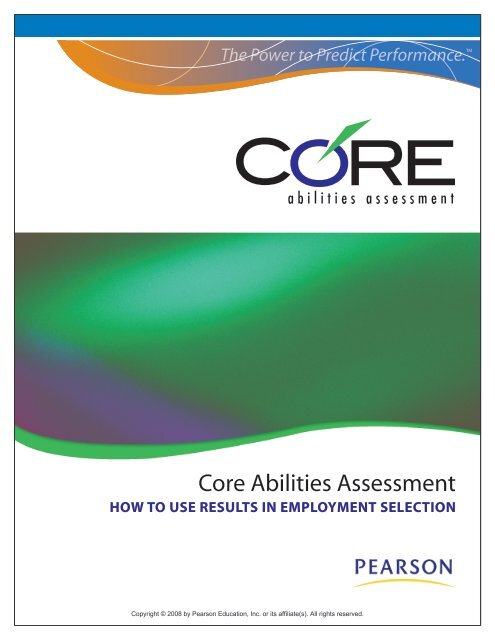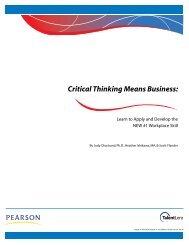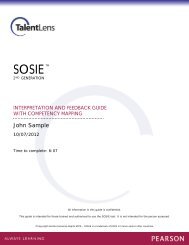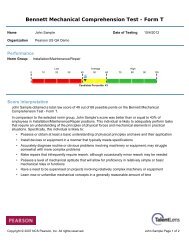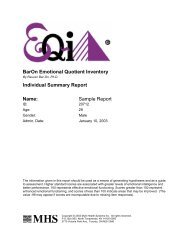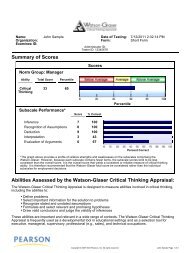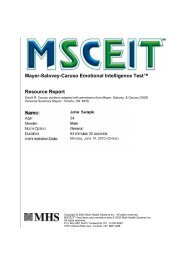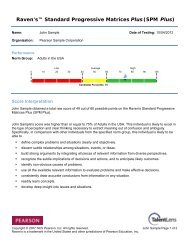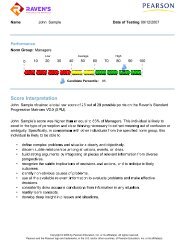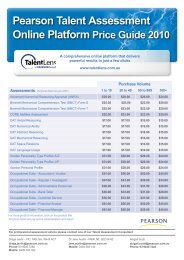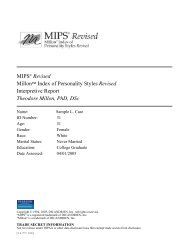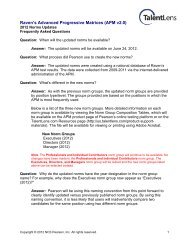How to Use Core Results for Employment Selection - Pearson ...
How to Use Core Results for Employment Selection - Pearson ...
How to Use Core Results for Employment Selection - Pearson ...
Create successful ePaper yourself
Turn your PDF publications into a flip-book with our unique Google optimized e-Paper software.
<strong>Core</strong> Abilities Assessment<br />
how <strong>to</strong> use results in employment selection<br />
Copyright © 2008 by <strong>Pearson</strong> Education, Inc. or its affiliate(s). All rights reserved.
<strong>Core</strong> Abilities Assessment<br />
<strong>How</strong> <strong>to</strong> <strong>Use</strong> <strong>Core</strong> Abilities Assessment<br />
<strong>Results</strong> in <strong>Employment</strong> <strong>Selection</strong><br />
Understanding the Scores Reported<br />
The interpretive report includes a <strong>to</strong>tal raw score as well as a percentile score corresponding <strong>to</strong><br />
the <strong>to</strong>tal raw score. The percentile score is a standardized score that indicates the standing of<br />
the candidate relative <strong>to</strong> individuals in the norm group. The percentile score indicates the<br />
proportion of the norm group who possess less of the ability than the candidate. For example, if<br />
a candidate’s <strong>Core</strong> Abilities Assessment score is at the 75 th percentile of a given norm group, it<br />
means that the candidate scored higher than or equal <strong>to</strong> 75% of the people in the norm group. A<br />
score above the 50 th percentile is considered above average in comparison <strong>to</strong> the norm group.<br />
Using Local Norms Developed with the Wonderlic<br />
Personnel Test<br />
The Wonderlic Personnel Test (WPT; Wonderlic, 1992) is a commonly used assessment of<br />
general mental ability. <strong>Core</strong> Abilities Assessment scores correlate highly with WPT scores<br />
(<strong>Pearson</strong> Education, Inc., 2007).<br />
Table 1 presents <strong>to</strong>tal raw score equivalents <strong>for</strong> the WPT and the <strong>Core</strong> Abilities Assessment.<br />
This table can be used <strong>for</strong> the conversion of any <strong>to</strong>tal raw score on the WPT <strong>to</strong> the equivalent<br />
<strong>to</strong>tal raw score on the <strong>Core</strong> Abilities Assessment, and vice versa. The conversion table is based<br />
on estimates of ability using the Rasch model (Rasch, 1980).<br />
- 1 -<br />
Copyright © 2008 by <strong>Pearson</strong> Education, Inc. or its affiliate(s). All rights reserved.
Table 1. Conversion Table of Total Raw Scores on the Wonderlic Personnel Test and<br />
<strong>Core</strong> Abilities Assessment<br />
Wonderlic<br />
Personnel Test<br />
Raw Score<br />
<strong>Core</strong> Abilities<br />
Assessment<br />
Raw Score<br />
41–50 20<br />
35–40 19<br />
33–34 18<br />
30–32 17<br />
28–29 16<br />
26–27 15<br />
25 13–14<br />
24 11–12<br />
23 10<br />
22 9<br />
20–21 8<br />
17–19 7<br />
15–16 6<br />
13–14 5<br />
11–12 4<br />
7–10 3<br />
4–6 2<br />
2–3 1<br />
0–1 0<br />
Making <strong>Selection</strong> Decisions<br />
A key consideration in using the <strong>Core</strong> Abilities Assessment as part of a selection process<br />
involves establishing how <strong>to</strong> combine the results from the assessment with other in<strong>for</strong>mation<br />
obtained throughout the selection process. Many organizations use a holistic approach in which<br />
the interview, résumé review, assessment results, and other in<strong>for</strong>mation are considered,<br />
collectively, <strong>to</strong> generate a comprehensive profile of each candidate. This approach recognizes<br />
that multiple predic<strong>to</strong>rs typically produce the most reliable and accurate prediction of<br />
job per<strong>for</strong>mance.<br />
Another popular alternative is <strong>to</strong> use the <strong>Core</strong> Abilities Assessment as a screener <strong>to</strong> determine<br />
which candidates are best qualified <strong>to</strong> advance <strong>to</strong> the next step in the selection process. The<br />
advantage of this is that it can increase efficiency and reduce the cost and time spent using<br />
more expensive selection procedures (e.g., behavior-based interviews conducted by hiring<br />
managers) <strong>to</strong> differentiate unqualified candidates from appropriate ones.<br />
- 2 -<br />
Copyright © 2008 by <strong>Pearson</strong> Education, Inc. or its affiliate(s). All rights reserved.
We do not establish or recommend a passing score (cut score) <strong>for</strong> the <strong>Core</strong> Abilities<br />
Assessment. Your organization should set appropriate cut scores after careful consideration of<br />
fac<strong>to</strong>rs unique <strong>to</strong> the organization (e.g., the supply of talent in the local labor market, and the<br />
emphasis and urgency <strong>for</strong> keeping jobs filled). In general, the higher a cut score, the higher the<br />
likelihood of success <strong>for</strong> candidates who score above the cut score. Arbitrary cu<strong>to</strong>ffs should be<br />
avoided, because they can introduce disparate impact in<strong>to</strong> a selection process. The best<br />
solution is local validation, which involves relating assessment scores with job per<strong>for</strong>mance<br />
within the client’s organization. Local validation provides the best foundation <strong>for</strong> interpreting<br />
scores and differentiating candidates who are likely <strong>to</strong> be successful from those who are not.<br />
Moni<strong>to</strong>ring the <strong>Selection</strong> System <strong>for</strong> Adverse Impact<br />
Assessment results (or any assessment metric used in decision making) should be evaluated<br />
<strong>for</strong> evidence of adverse impact. According <strong>to</strong> the Uni<strong>for</strong>m Guidelines on Employee <strong>Selection</strong><br />
Procedures (Equal <strong>Employment</strong> Opportunity Commission, 1978), adverse impact in an<br />
assessment is indicated when the selection rate <strong>for</strong> a protected group is less than 80% of the<br />
selection rate <strong>for</strong> the majority group. If a selection system demonstrates adverse impact under<br />
these terms, a local validation study showing that the employment assessment <strong>to</strong>ol is equally<br />
predictive <strong>for</strong> protected groups will help demonstrate that the assessment is fair, as outlined by<br />
the Equal <strong>Employment</strong> Opportunity Commission.<br />
An organization’s ability <strong>to</strong> evaluate selection strategies and implement fair employment<br />
practices is dependent upon knowledge of the demographic characteristics of applicants and<br />
incumbents. Moni<strong>to</strong>ring these characteristics and accumulating assessment score data are<br />
clearly necessary <strong>for</strong> establishing the legal defensibility of a selection system, including those<br />
systems that incorporate the <strong>Core</strong> Abilities Assessment. The most effective use of the <strong>Core</strong><br />
Abilities Assessment will be achieved where a local norms database is established and regularly<br />
updated and moni<strong>to</strong>red <strong>for</strong> compliance with applicable policies and best practices.<br />
Maintaining Security of <strong>Results</strong> and Materials<br />
<strong>Core</strong> Abilities Assessment scores are confidential and should be s<strong>to</strong>red in a secure location<br />
accessible <strong>to</strong> authorized individuals only. It is unethical as well as poor assessment practice <strong>to</strong><br />
allow assessment score access <strong>to</strong> individuals who do not have a legitimate need <strong>for</strong> the<br />
in<strong>for</strong>mation. The security of assessment materials (e.g., access <strong>to</strong> online assessments) and<br />
protection of copyright must also be maintained by authorized individuals.<br />
- 3 -<br />
Copyright © 2008 by <strong>Pearson</strong> Education, Inc. or its affiliate(s). All rights reserved.
Sources of Additional Best Practice In<strong>for</strong>mation<br />
Governmental and professional regulations cover the use of all personnel selection procedures.<br />
Relevant source documents that the user may wish <strong>to</strong> consult include the Americans With<br />
Disabilities Act of 1990; the Principles <strong>for</strong> the Validation and <strong>Use</strong> of Personnel <strong>Selection</strong><br />
Procedures (Society <strong>for</strong> Industrial and Organizational Psychology, 2003); the Standards <strong>for</strong><br />
Educational and Psychological Testing (American Educational Research Association, American<br />
Psychological Association, & National Council on Measurement in Education, 1999); and the<br />
federal Uni<strong>for</strong>m Guidelines on Employee <strong>Selection</strong> Procedures (Equal <strong>Employment</strong> Opportunity<br />
Commission, 1978). For an overview of the statutes and types of legal proceedings that<br />
influence an organization’s equal employment opportunity obligations, the user is referred <strong>to</strong> the<br />
U.S. Department of Labor’s (1999) Testing and Assessment: An Employer’s Guide <strong>to</strong><br />
Good Practices.<br />
- 4 -<br />
Copyright © 2008 by <strong>Pearson</strong> Education, Inc. or its affiliate(s). All rights reserved.
References<br />
American Educational Research Association, American Psychological Association, & National<br />
Council on Measurement in Education. (1999). Standards <strong>for</strong> educational and<br />
psychological testing. Washing<strong>to</strong>n, DC: Author.<br />
Americans With Disabilities Act of 1990, Titles I & V (Pub. L. 101–336). United States Code,<br />
Volume 42, Sections 12101–12213.<br />
Equal <strong>Employment</strong> Opportunity Commission. (1978). Uni<strong>for</strong>m guidelines on employee selection<br />
procedures. Federal Register, 43(166), 38295–38309.<br />
<strong>Pearson</strong> Education, Inc. (2007). <strong>Core</strong> Abilities Assessment: Evidence of Reliability and<br />
Validity (Tech. Rep.). San An<strong>to</strong>nio, TX: Author.<br />
Rasch, G. (1980). Probabilistic models <strong>for</strong> some intelligence and attainment tests. Chicago:<br />
University of Chicago Press.<br />
Society <strong>for</strong> Industrial and Organizational Psychology. (2003). Principles <strong>for</strong> the validation and<br />
use of personnel selection procedures (4 th ed.). Bowling Green, OH: Author.<br />
U.S. Department of Labor. (1999). Testing and assessment: An employer’s guide <strong>to</strong> good<br />
practices. Washing<strong>to</strong>n, DC: Author.<br />
Wonderlic, E. F. (1992). Wonderlic Personnel Test and scholastic level exam user’s manual.<br />
Libertyville, IL: Wonderlic Personnel Test.<br />
- 5 -<br />
Copyright © 2008 by <strong>Pearson</strong> Education, Inc. or its affiliate(s). All rights reserved.
Copyright © 2008 by <strong>Pearson</strong> Education, Inc. or its affiliate(s). All rights reserved.


